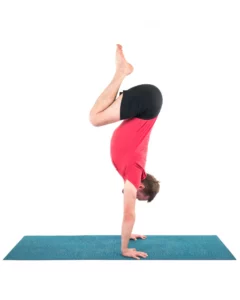Yoga 2.0: Align and Refine Pyramid Pose and Revolved Triangle Pose

Pyramid Pose (also known as Intense Side Stretch or Parsvottanasana) is a strong standing pose that lengthens the entire posterior chain and the sides of the waistline. It’s very similar to Revolved Triangle Pose (Parivrtta Trikonasana), another strong standing posture that revolves the spine. (1)
Because their foundation is the same, Pyramid Pose and Revolved Triangle Pose are great postures to work in sequence. One builds on top of and informs the alignment of the other.
Try This Simple Sequence to Align and Refine Your Pyramid Pose and Revolved Triangle Pose
These postures are both standing balances (since your legs are staggered) that require a fair level of flexibility and mobility. So grab two blocks to help you play with the alignment and balance in these postures.
Start in Mountain Pose (Tadasana)
- Set your two blocks at their highest height, at the top of your mat, about shoulder-width apart.
- Come to stand just behind the blocks in a strong Mountain Pose with your feet hip-distance apart. Stand tall through your spine and three-dimensionally corset your waistline inward.
- Draw your hands to rest on your hips.
Step One Foot Back
- Ground strongly into your right foot and step your left foot toward the back of your mat. Step back about 3.5 to 4 feet. If you feel tighter in your legs, give yourself even more length between your feet.
- Angle your back toes out slightly, toward a 45-degree angle if that feels comfortable.
- You can align your heels with each other in one straight line or stagger your legs a little bit farther apart from each other as if you’re standing on railroad tracks. The latter option will be more stable.
Square Forward
- Try to square your shoulders, ribs, and hips toward the top of your mat.
- Draw your right hip toward the back of your mat and roll your right shoulder and the right side of your ribcage back behind you.
- Gently draw your left hip forward toward the top of your mat.
- Energetically, scissor your legs toward each other to turn your whole pelvis to face directly forward.
Hinge Forward into Pyramid Pose
- Ground firmly into your left heel and hinge from your hips to fold your torso forward over your front leg.
- As your hips reach backward, stretch the crown of your head forward so that you lead with your chest and an elongated spine as you fold.
- Place your hands on the blocks just slightly forward of your feet.
Walk Your Hands Forward
- You have the option to stay as you are or the option to walk your blocks and your hands forward toward the top of your mat (or even off it) and allow your arms to create a longer lever to pull even more length across your side bodies and create that intense side stretch found in the name of the pose.
- Energetically draw your hips toward the back of your mat to keep both sides of your waist equally long as your sternum reaches forward.
- Lengthen across your whole back body and hold for a few deep breaths here in Pyramid Pose.
Prepare for Revolved Triangle Pose
- Slowly walk your blocks and your hands back in to frame your front foot.
- Draw your right hand to your hip and use your hand to manually draw your right hip toward the back of your mat.
- Maintain the length you created on both sides of your waist, and either keep your left hand on your block where it is or place it on the opposite block on the pinky side of your front foot. Your block can be at any height setting you like.
Come Into Revolved Triangle Pose
- Root into your back heel and reach your chest straight forward toward the top of your mat.
- Keep your rib cage moving away from your pelvis as you twist your torso toward the right.
- Option to reach your right hand toward the ceiling.
- With every inhalation, move your rib cage away from your pelvis. With every exhalation, twist around that and hold for a few long, deep breaths in your Revolved Triangle Pose.
Release Back Out
- To come out, reach your right arm toward the back of your mat and then circle it down toward the floor.
- Shift your gaze downward to help stabilize your balance.
- And circle your left arm around and up as you rise to stand.
- Draw your feet parallel and step your feet back together into Mountain Pose before repeating the whole sequence on the other side.
The Takeaway on Pyramid Pose and Revolved Triangle Pose
Both the Pyramid Pose and the Revolved Triangle Pose are challenging postures, so be gentle with yourself as you work on this short sequence. Both positions require stable balance and flexibility to feel at ease in the shapes.
So take your time and practice diligently and consistently; soon enough, these two postures might be your new favorite poses!
Also, read...
Change Your Perspective of Pelvic Tilting: How the Transversus Abdominis Can Help
4 Ways to Practice Locust Pose
5 Keys to Healthy Neck Alignment in Cobra Pose (Bhujangasana)
Related courses
Breath as Medicine: Yogic Breathing for Vital Aging
Yoga and Myofascial Release: Releasing Chronic Tension with the Bodymind Ballwork Method
Yoga and Detoxification: Tips for Stimulating Lymphatic Health

Leah Sugerman is a yoga teacher, writer, and passionate world traveler. An eternally grateful student, she has trained in countless schools and traditions of the practice. She teaches a fusion of the styles she has studied with a strong emphasis on breath, alignment, and anatomical integrity. Leah teaches workshops, retreats, and trainings, both internationally and online. For more information, visit www.leahsugerman.com.
- Vertebral column. (2024, September 4). In Wikipedia. https://en.wikipedia.org/wiki/Vertebral_column






